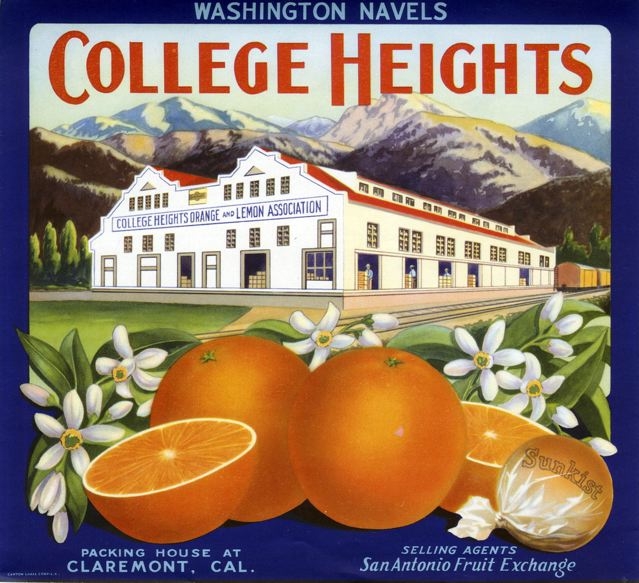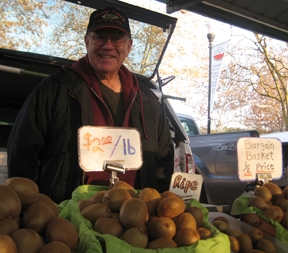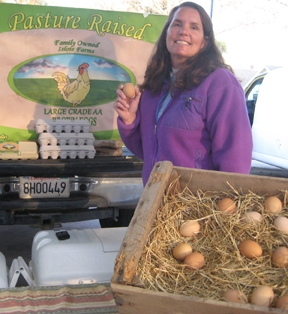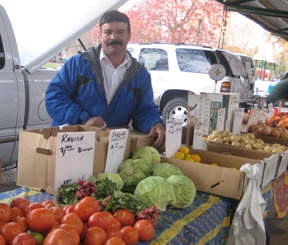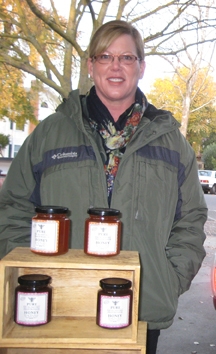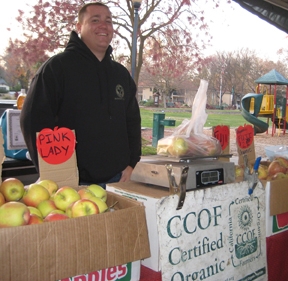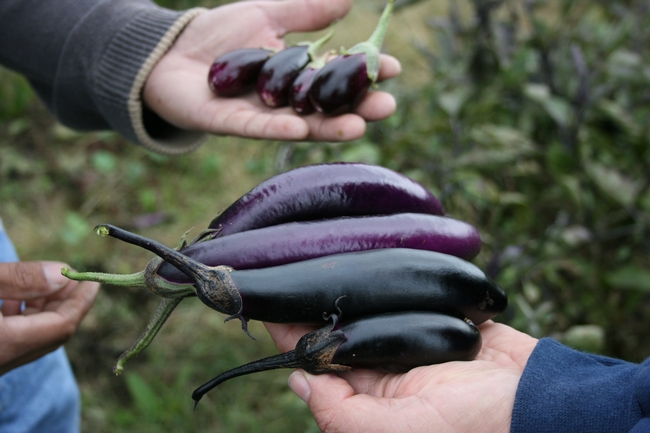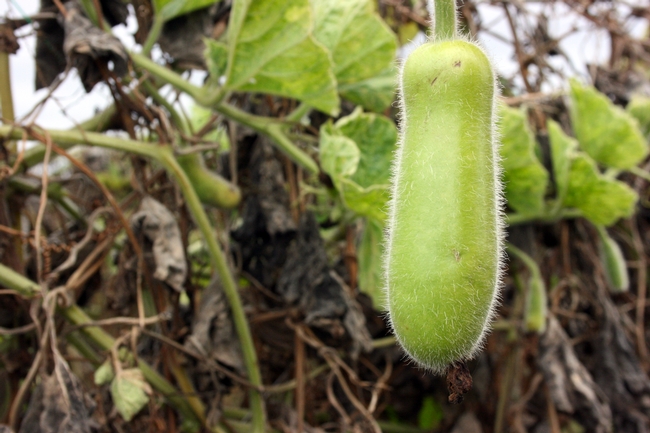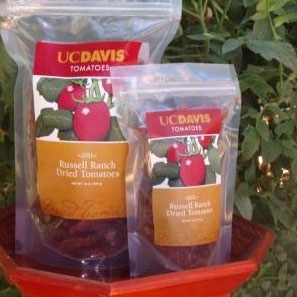UC Food Blog
Los Angeles and the “Orange Empire”
An interesting book called “Orange Empire: California and the Fruits of Eden” by Douglas Cazaux Sackman tells the story of how oranges went from being an occasional treat to a mainstream part of the American diet. In fact, Los Angeles was once the center of the “Orange Empire” which developed into a massive industry in California.
Oranges were brought by the Spanish as they settled the missions, and the first sizable grove in Alta California was planted at the San Gabriel Mission, near Los Angeles, around 1804. Oranges were grown on a very limited scale until a frontiersman and entrepreneur named William Wolfskill decided to try growing oranges commercially, using seedlings from the Mission. His initial two-acre orchard was planted in 1841 in what is now downtown Los Angeles. During the Gold Rush, he was able to ship his citrus crop north to miners who were willing to pay a premium to protect themselves from scurvy.
The citrus industry in Southern California grew slowly at first, then really took off in the 1870s due to two innovations. First, a family in Riverside obtained two trees of an orange variety from Brazil. The fruit from these trees was larger, sweeter and easier to peel. This variety, which came to be known as the Washington Navel, created a surge of interest in growing oranges. In the same decade, the transcontinental railroad system connected to Los Angeles, and the very first railcar load of oranges, from the Wolfskill orchard, was shipped east in 1877. In the late 1880s, with the advent of refrigerated rail shipping, the growing citrus industry got another boost. Many new growers entered the citrus farming business, and numerous towns along the foothills of the Los Angeles basin were formed as the industry grew up in those areas.
“Centered on the Los Angeles basin, a vast citrus landscape was coming into being,” said Sackman (p.42). “In 1870, only 30,000 orange trees were growing in the state. Twenty years later, 1.1 million trees were producing fruit." By 1893, local citrus growers had organized themselves into the Southern California Fruit Growers Exchange, which later became known as Sunkist. Sunkist was instrumental in driving the demand for oranges, promoting oranges and orange juice as health aids, with national advertising campaigns beginning in 1907. Sunkist advertisements, along with colorful orange crate labels, helped to brand Los Angeles and Southern California as a new Eden, the land of sunshine and good health. This image helped to drive migration from to Southern California for many years.
Commercial citrus production in Los Angeles County began to decline after World War II, as orchards were rapidly sacrificed to the growing, sprawling suburbs of the Los Angeles basin. As recently as 1970, there were still more than 50,000 acres of citrus in the county; but today, most orange trees in Los Angeles are in backyards rather than in groves.
The citrus industry, still critical to California’s agricultural economy, has long since moved to other counties and other parts of the state. While there is no longer an “Orange Empire” here in Los Angeles, oranges are still a treat, especially if grown in our own backyards. As I prepare for the holidays, I know that today, an orange in a stocking might not be as special as it once was. But to pluck an orange off a tree, on a 75 degree day in December, still makes Los Angeles seem like Eden to a former Midwesterner like me.
December farm stories
Davis Wednesday afternoon farmers' market can be quiet in December, so what better time to learn a little about what's going on back at the farms? Every farmer I talked with today had delicious treats to sell and a story to tell. Here are a few:
Did you know that Gridley is the kiwi capital of America? There used to be a kiwi festival and a kiwi queen, but that all got too expensive for Gridley's kiwi farmers quite a few years ago, Frank Stenzel reports. He's getting ready to start pruning his 14 acres of kiwi vines next week; pruning will take a crew of 12 about two weeks. After pruning, each of the 25 or 30 canes on each kiwi vine will need to be tied to a trellis, very much like grape vines, to be ready for next year's growth.
The fuzzy green fruit for sale today from Stenzel's Kiwi Farm was harvested late in October and has been held in cold storage at 32 degrees since then. The fruit will last about six months stored this way, allowing Stenzel to bring out what he needs, grade it by size, let it ripen a little, but sell it while it's still firm. When you bring your kiwis home, let them ripen three or four days more for the best flavor.
Now that the weather is getting colder, the older chickens at Annette Jones' Islote Farms in Esparto have started molting. For a few weeks, they will lose feathers and stop laying eggs. But Jones isn't worried; in fact, she planned for this. Younger hens are picking up the slack because they hatched later in springtime and are just starting to lay eggs in December and January. The older hens can take their much needed break while the youngsters get busy. The fresh eggs from the younger hens are available at the market today in small and medium sizes. When springtime comes, all the birds will be laying again and eggs will be plentiful.
On Federico Toledo's Toledo Farm in Lodi, his son, brother, brother-in-law and other family members are busy planting this month - cabbages, broccoli, cauliflower, spinach, beets, cilantro, carrots, onions and curly parsley. What they're planting now will be at the farmers markets in March, April and May, if the weather cooperates. The 20 long rows of onions going in now will yield green onions in February and March, full-size fresh onions in April and May, and then dry onions in June and July. Today's market table has stories too: The last red tomatoes of the year are for sale today; they were picked green in November and ripened with a heater. The winter squash was actually grown in summer and harvested in August - it gets sweeter over the months and keeps well in winter. The persimmons, grapefruit, lemons and apples were all fresh-picked by the farm family.
All the rice has been harvested now at Robin Harlan's Bullfrog Farms in Winters, and the 3,000 hives of Bullfrog Bees are getting pollen patties to make it through the winter since there aren't enough blossoms to keep them fed without help this time of year. There's time now for bottling the honey; it's been stored in big stainless steel barrels since the Harlans harvested it in the summer. Bullfrog Farms grows more than 200 acres of almond trees which start blooming in January, so the bees will have blossoms very soon to pollinate and pollen to gather for more honey. After working in the Bullfrog orchards, they'll go to Blue Diamond almond orchards, and then to orange groves in Winters. Local honey is the sweet result of these hard-working bees.
Todd Evans works at certified organic Mount Moriah Farms in Clements. Today he's selling crisp Fuji and Pink Lady apples. Up until two days ago, Evans, farm owner Steve Smit, and a couple of other guys were harvesting apples. Now they're getting ready to prune all the trees, which will take the four of them about a month. The apples should last in storage until about May, just long enough for the cherries to be ready.
Give it a try - visit your local winter farmers market and learn some new stories!
To find farmers' markets in your community, visit the UC small farm program's California Agriculture Tourism Directory.
When vegetables become an adventure
Walking through a field lined with row upon row of different vegetables — many ready for the picking — can be an exercise in abundance. When you're faced with the prospects of a huge, just-picked Japanese cabbage or spicy green lo bok pulled fresh from the ground, suddenly vegetables might seem like less of a chore and more of an adventure.
I had a chance recently to visit Tchieng Farms with Richard Molinar and Michael Yang, both of UC Cooperative Extension Fresno County and the Small Farm Program. This pair has been part of the Great Veggie Adventure over the last several months along with the rest of the Small Farm Program team.
We were visiting the farm to share some new "veggie adventures" that went beyond the four colorful vegetables highlighted in this project (to refresh your memory, the Great Veggie Adventure highlighted Romanesco, rainbow carrots, party cauliflower and watermelon radishes).
Molinar and Yang showed me many vegetables I had never tried, including moqua, sinqua, long beans, lo bok, opo and winter melon.
"One of the exciting things about this job is you always learn something new," Molinar said. "Our specialty is with the Asian vegetables, with Michael's expertise in that area. Asians have vegetables that are unique to their culture, that they prefer — just like Punjabis have vegetables unique to their culture, and Hispanics have vegetables common to them."
We walked between the trellised crops and up and down the plant rows, while Yang and Molinar picked samples and talked about how to eat these new-to-me vegetables.
Yang pointed out that sometimes Asian vegetables include familiar varieties that are grown and eaten in less familiar ways. For example, many Hmong and Chinese farmers grow sugar snap pea plants for the tender shoots, tendrils and leaves instead of the pea pod.
Make sure to watch our short video from that day:
Still curious?
- Find more information about growing Asian vegetables from the UC Small Farm Program
- Visit the official Great Veggie Adventure website by the makers of Hidden Valley Salad Dressings
- Watch more videos from our Great Veggie Adventure playlist
Dried tomatoes are a healthful stocking stuffer
Adding to a growing list of campus-produced products, Russell Ranch has introduced a new UC Davis product -- Russell Ranch Dried Tomatoes.
Russell Ranch Dried Tomatoes are grown at UC Davis' Russell Ranch Sustainable Agriculture Facility, a 300-acre farm west of campus. The organically grown tomatoes are part of a century-long study of agricultural sustainability at the ranch that compares the long-term effects of different ways of farming.
Research at Russell Ranch focuses on soil and water quality, nutrient cycling, pests and profitability.
“We developed this product to help meet a campus desire for more locally grown food. We also wanted to share with those on and off campus what’s happening at Russell Ranch. It is unique for a research farm of this size to be entirely dedicated to a century-long study of agricultural sustainability, and it is the only one of its kind in Mediterranean ecosystems,” said Kate Scow, director of Russell Ranch, which is a program of the Agricultural Sustainability Institute at UC Davis.
After years of selling tomatoes off campus, Russell Ranch staff began working with UC Davis Dining Services as it sought more sources of locally grown food in order to reduce the carbon footprint of food served on campus. For the past two years, freshly harvested Russell Ranch tomatoes have been used in the Russell Ranch Roasted Tomato Sauce that accompanies a variety of dishes - from pizza to polenta and ratatouille - served on campus.
This year, Russell Ranch staff developed a new limited-quantity product that can be enjoyed on and off campus.
Russell Ranch Dried Tomatoes are also available at the Memorial Union Coffeehouse, the UC Davis Medical Center and for purchase through the UC Davis Bookstore.
$4 for a 2.75 oz. bag
$12 for a 9.75 oz. bag
UC CalFresh helps low-income consumers choose healthful foods
UC’s Food Stamp Nutrition and Education Program, or FSNEP, has officially changed its name to University of California CalFresh Nutrition Education Program, or UC CalFresh for short.
In 2008 the U.S. Department of Agriculture’s Food and Nutrition Service changed the name of the food stamp program to the Supplemental Nutrition Assistance Program (SNAP). Last year, the California Department of Social Services updated to CalFresh, the name of the state program that issues monthly electronic benefits that can be used to buy food.
“Since food stamps are no longer used nationally, and the name has been changed, we have needed to change our name to conform with the USDA and CDSS changes,” said David Ginsburg, director of UC CalFresh.
The federal food assistance program, which started in 1939, was created to improve the nutritional status of low-income people.
UC CalFresh provides nutrition education to children and adults who participate in CalFresh in 33 counties. In 2011 UC Cooperative Extension provided nutrition education on topics ranging from healthy food choices to money and resource management to approximately 140,000 Californians who were eligible to receive CalFresh benefits.
In Santa Clara County, UC CalFresh staff members have worked with more than 520 families over the past year. UC Cooperative Extension nutrition advisor Susan Algert recently tested the effectiveness of a three-class UC CalFresh series focused on shopping, resource management, food safety and a healthy diet. Algert and colleague Carmen Simmons documented changes in the home food environment of five Hispanic families participating in the Eat Smart Be Active classes in Santa Clara County. Four families who were not participating in the classes were also recruited for the project as a control group. All of the children in the families were participating in UC Cooperative Extension nutrition education lessons in their schools.
Algert and Simmons found that making a shopping list, planning menus, shopping less often and using leftovers were the most effective tactics to help families save money on food. At the same time, the families increased the fruit and vegetable variety in their diets by 30 percent, increased the amount of fresh fruit by 30 to 50 percent and increased the use of whole wheat bread by 75 percent.
One participant said, “I learned very much about how to stretch my food dollar until the end of the month, something I couldn’t do before."
For more information, visit the UC CalFresh website at uccalfresh.org.


